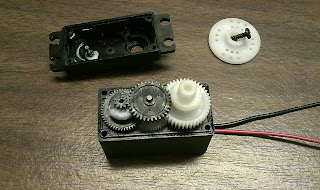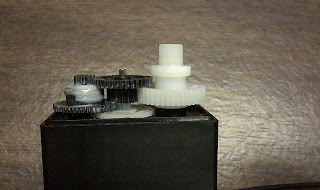Things are moving along for me on my robot build for the Make: Robot Build Contest. I'm having a blast!
So, my next step is to modify a servo for continuous rotation. Most servos are designed to allow only a limited degree of freedom in rotation and the Hitech HS-322HD that comes in the Jameco build kit is no different. Since we're going to mount wheels to each servo, we'd really like for them to be able to turn (and keep turning) 360 degrees in either direction.
I'm going to use a couple special tools. The first is a desoldering vacuum, or "solder sucker" as some might call it. This will help remove solder when I desolder the servo's controller board from the motor. The second tool is a micro cutter. This is basically a small pair of snips.
Here is our unmodified servo, a Hitech HS-322HD.
First, we're going to remove the four screws from the bottom of the servo and lift off the bottom cover.
Next, we'll desolder the motor from the controller board. We do this primarily so that we can remove the potentiometer in a later step without damaging it. To desolder the motor, heat the two solder lugs on the motor (the two big solder joints at the opposite end of the servo from where the control wires enter), one at a time, and use the desoldering vacuum to pull the solder from the lugs. Once all the solder is removed, use a small, flat screwdriver to lift the controller board away from the motor.
One you have the controller board free from the motor, you will see three wires running from the board to a potentiometer. There is a small screw holding the potentiometer in place. Remove the screw, free the potentiometer, and pull the entire controller unit free from the servo.
So, now we have separated the controller from the servo. In the future we can reinstall it back into the servo for another project, use it separately in another project, or raid it for its parts!
Our next step will be to solder two wires to our motor. You could use the original control wires from the servo, but I chose to just add a couple of my own. I fashioned a small hook in the end of each wire to loop through the lugs of the motor. This will help avoid having the wires easily pulled out of the servo.
Once we have the wires hooked through the lugs, crimp them with a pair of needle-nosed pliers to help hold them in place. Then solder the wires to the motor lugs.
Our motor is all set now, so we need to concentrate on the gears next. There is a small tab on the main drive gear that was originally designed to keep the servo from rotating completely. We need to remove the tab, so remove the top cover of the servo to expose the gears, starting by removing the screw and wheel on top of the servo.
Let's take a profile picture of the gears so that we can remember how they were assembled! Then we'll remove the main gear (large white gear) and separate the bearing sleeve from it.
In the close-up picture, you can see the small tab that we need to remove so that the gear will be able to rotate fully. There are some options regarding how to remove the tab. I opted to use a pair of micro snips to avoid getting sawdust in the grease. However, you could likely use a small dremel cutter to saw it. I also read about someone melting the tab to remove it. The danger in using the snips is that it could cause the gear shaft to split. I read about this possibility in a number of online posts where folks had accidentally split the gear or gear shaft when cutting. To try to minimize this possibility, I decided to make my first cut parallel to the gear shaft and then make my second cut perpendicular to the shaft. To further minimize the risk, I made sever small cuts in this fashion as opposed to trying to remove the tab with only two large cuts.
Once the tab has been removed, it should be nice and flush with the gear so that it does not catch the stop that is built into the case of the servo.
We can now reassemble the gears. Don't forget to place the bearing sleeve back onto the main drive gear.
You can now replace the top and bottom covers of the servo and mount the wheel to the main drive gear instead of the original white horn disk.
Now we can test the servo to make certain it turns continuously in both directions. If you have your voltage regulator built, you can connect the servo wires to the power bus of your breadboard. Once you are sure it turns in one direction, flip the polarity of the wires and try it the other direction. This isn't quite the way the servos will be powered in our final robot, but it is a good test to make sure our modification was successful.
Subscribe to:
Post Comments (Atom)




























No comments:
Post a Comment